Istanbul The Hagia Sophia Mosque
The Hagia Sophia Mosque
The Hagia Sophia Mosque is an important structure located on the historic peninsula of Istanbul. His full name is known as "Ayasofya-i Kebir Mosque Sheriff". The structure was built by the Byzantine Emperor I. It was built by Justinian at the beginning of the 6th century. It was built at the turn of the century. Originally, Hagia Sophia was one of the largest and most important churches in the Byzantine Empire.
Construction of the Hagia Sophia began in 532 C.E. and was completed in just five years. The Hagia Sophia, which stood out for its architectural and engineering achievements at the time of its construction, remained the largest domed structure in the world for many years.
Located in Constantinople, the capital of the Byzantine Empire, the Hagia Sophia was converted into a mosque when the Ottoman Empire conquered Istanbul in 1453. Hagia Sophia, which was adapted to the mosque with some changes made after the conquest, became an important center of worship and culture during the Ottoman period.
Hagia Sophia is of great architectural importance. It is particularly remarkable for its dome, height and width. The mosaics, frescoes, and marble carvings in the interior are also attractive to visitors. Since Hagia Sophia is a structure that bears the traces of different periods, it combines architectural elements of the Byzantine, Ottoman and modern periods.
In 2019, it was decided that the Hagia Sophia would be removed from museum status and used as a mosque again. This decision sparked controversy and generated widespread reactions around the world. In addition to being open for worship as a mosque, Hagia Sophia is also a place of great interest to tourists.
The Hagia Sophia Mosque has preserved its historical and cultural value to this day as one of the symbolic structures of Istanbul. Visitors have the opportunity to explore both a historical structure and experience an important religious center.
History of the Hagia Sophia Mosque
The history of the Hagia Sophia Mosque is quite ancient. The first was the Byzantine Emperor I in 537. It was built in Istanbul by Justinian. The construction of Hagia Sophia was designed as a magnificent Byzantine church and took about 5 years to complete.
Hagia Sophia served as the main cathedral of the Byzantine Empire from the time of its construction. Considered a great architectural achievement of its time, the Hagia Sophia became one of the symbols of Constantinople (today's Istanbul), the religious and political center of the Byzantine Empire.
However, with the conquest of Istanbul by the Ottoman Empire in 1453, Hagia Sophia was converted into a mosque. During the Ottoman period, various additions were made to the Hagia Sophia, which was used as a mosque, and it was adapted to Islamic architecture.
Later, in 1935, with the arrangements made during the Republic of Turkey, Hagia Sophia began to serve as a museum. Hagia Sophia, which used to be a museum, has become an open cultural and historical site for visitors.
Finally, on July 10, 2020, by the decision of the President of Turkey, it was reopened for worship as the Hagia Sophia Mosque and was again made available to Muslims. With this decision, Hagia Sophia continues to exist as a structure of both historical and religious importance.
Where is the Hagia Sophia Mosque?
Where is the Hagia Sophia Mosque? The Hagia Sophia Mosque is located in Istanbul, Turkey. Its location is in Sultanahmet Square, in the area known as the historical peninsula. The mosque is on the shore of the Sea of Marmara. The Palace of Topkapi and ... The Sultanahmet Mosque It's located nearby. The Hagia Sophia Mosque, located at a historically and touristically important point, is one of the most famous and visited buildings in Istanbul.
How to Get to the Hagia Sophia Mosque
How do we get to the Hagia Sophia is one of the questions that people wonder about. To get to the Hagia Sophia Mosque, you need to head to the Sultanahmet district in Istanbul's historic peninsula. Here are a few options on how to get to the Hagia Sophia:
Public transport In Istanbul, you can reach the Hagia Sophia by public transport. One of the most common options is to use the tram line. You can get off at the Sultanahmet tram stop by taking the "Bağcılar - Kabataş" tram, which follows the T1 line. Sultanahmet is located quite close to the Hagia Sophia Mosque.
Special vehicle: If you have your own car in Istanbul or if you have rented a car, you can get to the Hagia Sophia by your own car. However, there may be traffic and parking problems on the historic peninsula, so it is important to be careful and find a suitable parking space.
The taxi: Taxi service is quite common in Istanbul, and you can reach the Hagia Sophia by taxi. You can get to Hagia Sophia by going to any taxi stop in the city or by calling a taxi through mobile applications. However, when using a taxi, it is important to agree on the fare with the driver in advance or to have a taximeter used.
The Hagia Sophia Mosque, Istanbul will be visited Because it's in a region, it's usually in a place that's easy to find. Nevertheless, it is important to check the current traffic situation before the trip and determine the most appropriate transportation option.
The entrance fee to the Hagia Sophia Mosque?
The Hagia Sophia Mosque is one of the most iconic structures in Istanbul and is of great interest as a place that can be visited for free. With the arrangements made in 2020, Hagia Sophia began to be used as a mosque again and is open to visitors free of charge. This decision was an important milestone in the history of Hagia Sophia and made it more accessible to tourists and locals.
The Hagia Sophia Mosque is a tourist attraction visited by millions of people every year and has historical and cultural value. The magnificent mosaics, frescoes, and architectural details inside offer visitors a visual feast. The fascinating atmosphere and historical texture of Hagia Sophia gives visitors the opportunity to explore both a religious center and a journey into the depths of history.
When did the Hagia Sophia become a mosque?
When did the Hagia Sophia become a mosque? The Hagia Sophia was first built as a church in 537 during the Byzantine Empire. It was later converted into a mosque with the conquest of Istanbul by the Ottoman Empire in 1453. From this date, Hagia Sophia was used as a mosque for about 500 years.
However, in 1935, by a decision made by Mustafa Kemal Atatürk, the founder of the Republic of Turkey, the Hagia Sophia was closed for use as a museum. Later, in 2020, by the decision of the President of the Republic of Turkey Recep Tayyip Erdoğan, Hagia Sophia began to be used as a mosque again.
These changes are considered important turning points in the history of Hagia Sophia and have caused controversy. Hagia Sophia currently serves as a mosque in Istanbul.
Where is the Hagia Sophia Mosque?
The Temple of Hagia Sophia, first built by the Eastern Roman Empire in the 4th century, was a wooden-roofed basilica. The Temple of Hagia Sophia, built in the 20th century, was built in the form of a basilica with a wooden roof. Later, new buildings were built several times to replace this destroyed temple, but over time, these buildings were also destroyed. The foundations of its present form were laid in 537 AD, many repairs and additions were made over the years, and finally the four minarets made during the Ottoman period reached the present day. Hagia Sophia is considered an important landmark in the history of architecture due to its dome transition and carrier system features. It is the temple with the largest dome and interior at the time of its construction.
It has maintained this quality for almost 1,000 years. It is now the fourth largest domed mosque in the world. The Hagia Sophia, which also has the distinction of being the oldest cathedral in the world, is of great importance to both Christians and Muslims. After the conquest of Istanbul, it was converted into a mosque by Fatih Sultan Mehmet and thus became a symbol of the conquest. It contains very important works from both the church period and the period after it became a mosque. After the proclamation of the Republic, the Ayasofya Mosque, which was converted into a museum in 1935, regained the status of a mosque in 2020 and officially became the Ayasofya-i Kebir Mosque.
It is believed that the whole building turned towards the Kaaba as soon as Hazrat Alaihissalam inserted his finger into the copper-covered middle carved 'Terler Direk' on the left rear of the mosque in the northwest direction and began to rotate the column. Of course, this varies from person to person.


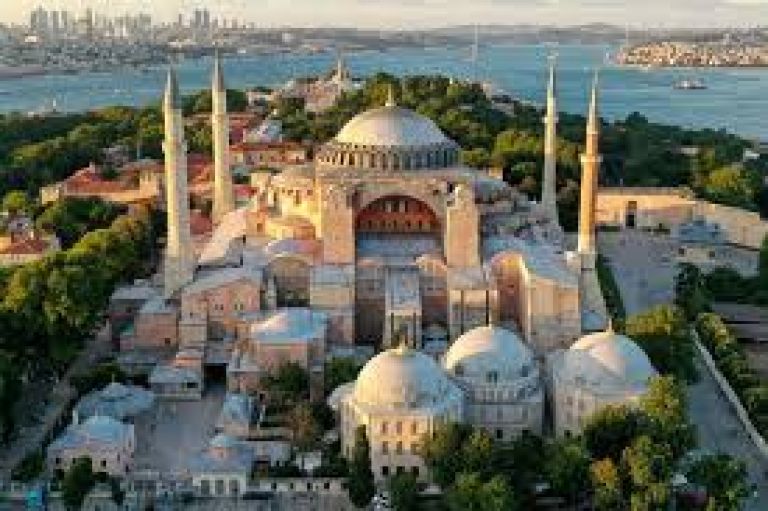
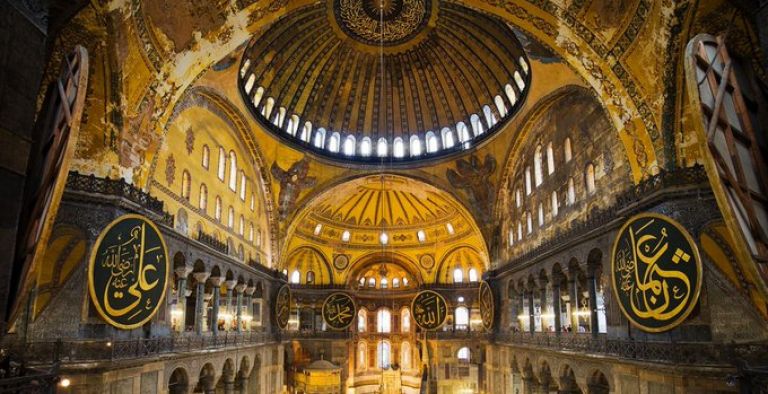
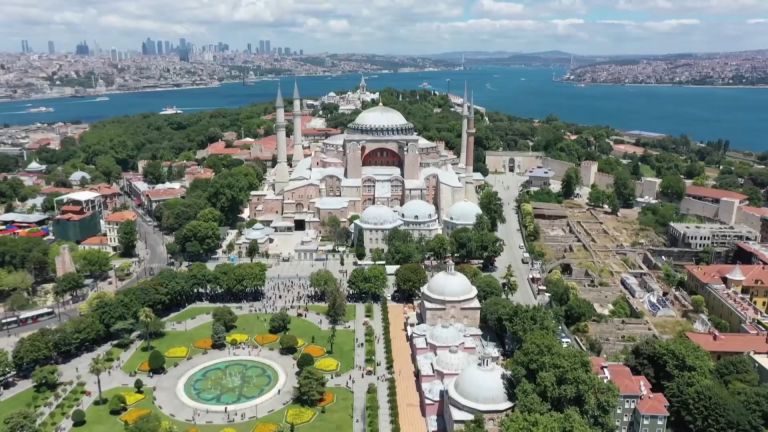
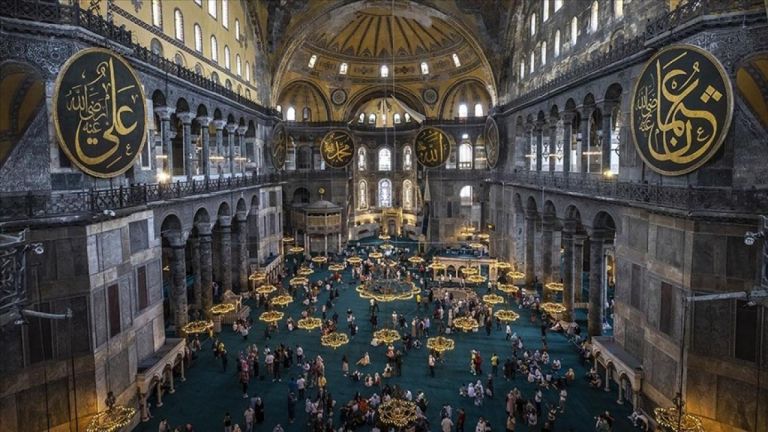





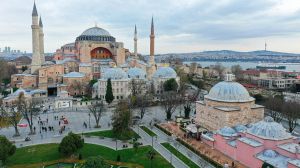
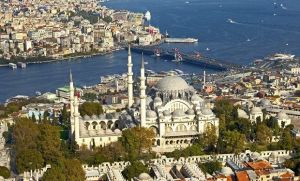
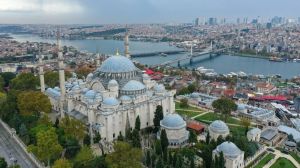
Değerlendirmeler